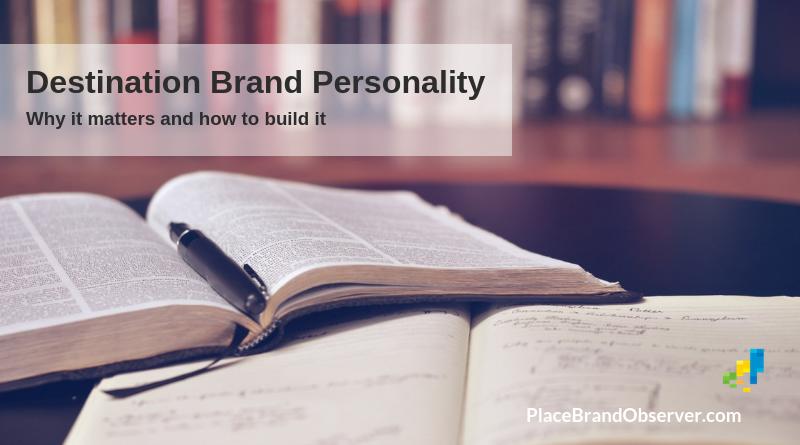Developing a destination branding strategy is difficult, but implementing it is even harder, especially building and nurturing a destination’s brand personality. To help destination brand managers and marketers with this difficult task, Sara Vinyals Mirabent together with Mihalis Kavaratzis and José Fernández Cavia, took a closer look.
We caught up with Sara to learn about the key findings of research which were recently published in the academic journal Tourism Management.
Sara, you recently published an article on the role of functional associations in building place brand personality. What brought you to investigating this topic?
We started working on this topic as a response to the struggles of destination brand managers to implement their brand strategy in their communication practices, and to manage such an abstract concept that is brand personality. Brand personality is a key component for the success of all branding strategies, and consequently, precise knowledge about this construct must be at the core of the scientific and practitioners’ interests.
So, one year ago, we started to study the official website communication of the 12 most visited cities in Europe, to identify the presence of traits of destination brand personality in their content.
What do you mean with “destination brand personality” – what is this all about?
We use brand personality as a metaphor that allows us to understand how people perceive brands and, particularly, destinations brands. Strictly speaking brands are non-living entities and thus cannot have personality; however, consumers attribute human traits to the brands they consume as a convenience to express themselves. Consumers’ relations with brands pursue not only satisfying physiological needs but also symbolic ones that contribute to the individual’s identity.
In other words, consumers build and project their identity also through their consumption practices. Thus, the perceived personality of a brand is a key element that significantly influences the choice of a particular brand; consumers look for brands that fit their own identity.
The theory around brand personality also applies to destination brands: tourists choose the destination not only according to the remarkable landmarks that they aim to see but also consider how well the character of the destination suits their own personality and identity path. As an example, someone connecting better with sophistication would choose Paris over many other European cities, while someone more lively and modern may choose Amsterdam.
Why do destinations need a brand personality to be successful?
Well, more than a matter of “need” this is a matter of “already having” a personality associated with the destination brand. Recommendations of friends, posts on social media, advertising… regardless of the source – the moment potential tourists first hear about a destination is the moment that they start building an image of this place. The more they hear, know, or experience a destination, the more characteristics they will link to the destination image, among them, personality traits.
So, in the current context where tourists are surrounded by so many messages, it is more than likely that, even if brand managers haven’t promoted it intentionally, people already have in their minds an opinion and an image of the destination. The challenge for destination brand managers is channeling this personality toward the strategic goals, rather than deciding to create one; spreading precise and conscious official messages is a good start.
How can destinations build and sustain their brand personality?
Working with brand personality in communication is a challenge due to the level of abstraction of the concept of personality. For instance, it is easier to write and communicate about the architecture and landscape of the destination than writing about the friendliness of the place; giving a description or adding a picture that shows personality is not as easy as doing so about famous buildings.
For this reason, the first highlight that one should take into account is that it is not only a matter of what you say but more about how you say it. Potential tourists infer personality traits from the way destinations communicate.
It is critical, then, that destination marketing organizations count with experts in communication capable of controlling the quality of the language used in their daily communications to match the strategic personality. The more consistent the destination’s communication, the higher the chance that tourists perceive the personality which brand managers aim for.
Even though in our study we focused on official websites communication, other resources, such as image and interactive content, and activities, such as selecting strategic ambassadors or organizing particular experiences and touch points between destinations and potential tourists, can also help brand managers to project the right personality.
Which are the main insights from your research?
In our research we found out that destination brand personality is not an isolated variable but it is influenced by other elements which are part of the overall destination image, such as the attractors of the destination. Elements such as natural environment, architecture, gastronomy, transportation, cultural activities, etc. have an impact on the perceived personality of the destination.
For instance, content about gastronomy contributes to a higher extent to strengthening a sophisticated personality of the destination, while information about mobility and transportation will emphasize a more competent personality.
This is a highly relevant finding for both academics and professionals. Future research shouldn’t study brand personality in isolation anymore; to fully understand the nature of this construct, further investigation should consider how other variables of destination image interact with the personality.
At a professional level, communication aiming to strengthen a destination’s personality will be more successful when considering those attractors that contribute the most to the type of personality that brand managers aim to position. Also, these findings make more attainable the process of communicating such an abstract concept that is personality; according to the research, brand managers can use the content about some attractors (tangible characteristics are easier to communicate) to reinforce certain traits of personality.
Which questions emerged during your research or when writing the article, which you think require further investigation?
We studied the official discourse but, of course, nowadays, the impression about a destination’s image and personality is built from a variety of sources of information. So, our research is an important step to understand how to communicate destination personality, and to help destination brand managers to channel it. However, further research should explore how different types of content from various sources contribute to its overall formation.
Your advice to destination brand professionals, how to approach brand personality building – do’s and don’ts?
I would suggest destination brand managers concentrate their efforts in three regards:
- Pay attention to how you talk: It is not enough with giving information anymore, you need to communicate, here is the key to project strong brand personality. Use vocabulary rich and expressive; vocabulary that not only describes but adds qualities of those elements described.
- Use the attractions: the content about the attractions of your destination will help you shape the desired personality. An excess of content about one particular characteristic can blur the overall personality proposition; this is especially important to consider in official websites content.
- Know who you are and be honest: the expectations that you create need to match the experience visitors will have; otherwise, tourists may become disappointed. Don’t try to project an image and personality that is not supported by the reality of your destination.
Anything else you’d like to mention?
Even though this is a significant advance in the field, there is still a long road ahead to undercover many particularities of brand personality. I believe that collaboration and initiatives that bridge research on the topic and actual branding cases are critical for future developments. So, I would like to encourage brand managers to rely on research, and to establish win-win partnerships between universities and brands.
Thank you, Sara.
The research article is available here.
 Dr. Sara Vinyals-Mirabent is the corresponding author and a postdoctoral researcher at the Department of Communication, Universitat Pompeu Fabra. She is part of the research group Communication, Advertising, and Society (CAS) and the research project ITOURIST, funded by the Spanish government. Her research interests are mainly centered on the areas of persuasive communication and place branding. In particular, she is currently working on the contribution of online communication practices to building brand image and personality and on the online informational habits of users.
Dr. Sara Vinyals-Mirabent is the corresponding author and a postdoctoral researcher at the Department of Communication, Universitat Pompeu Fabra. She is part of the research group Communication, Advertising, and Society (CAS) and the research project ITOURIST, funded by the Spanish government. Her research interests are mainly centered on the areas of persuasive communication and place branding. In particular, she is currently working on the contribution of online communication practices to building brand image and personality and on the online informational habits of users.
Enjoyed this research update on place brand personality: how to build it, what to keep in mind? Spread the word!


